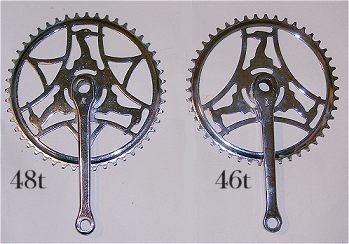

To 196?:
Until 196?, the Heron chainring featured a distinct pattern of three herons filling the chainwheel. In addition, six decorative braces form three triangular shapes between the Herons. An example of this chainring is shown in the photo above, to the left. These early cranks feature 48t, 1/8" thick chainwheels, and 6.5" crankarms. The reverse side of these chainrings will be stamped "48t."
196?-1972 & 73
On models produced after 196?, the original Heron chainring design was modified to a 46t variant, and the metal was thinned to 3/32" (singlespeed chain still required). The basic overall appearance remained the same. This variant is not shown above, but resembles the 48t variant, shown on the left. These chainwheels do not feature any stamping on the reverse of the chainwheel. This second variant was used until 1972, although excess stock of these chainrings at the factory had many of them finding their way onto 1973 models.
1973-1976
In 1973, the braces between the herons were deleted, along with the Herons' stamped-on eye detail. The steel's thickness remained at 3/32", and teeth count at 46t, no stamping on the reverse.
1977-1982
By 1977, the default clockwise direction of the Herons were officially flipped in the reverse direction to match the Raleigh logo itself rather then the chainwheel's direction of rotation
Oddball:
Gent's-frame Sports models with smaller frames then 21" featured slightly shorter cranks, identical in length to those used on the Raleigh Chopper. This example is not shown above.
Note: The chainring photographed so happens to have "reverse"-stamped Herons, facing counterclockwise (see an article on this on the Raleigh Chopper Info site explaining why). This is not a specific characteristic of these later cranks, counterclockwise-facing Herons could be found on any of the the three variations above. It's not common to find them, but they do exist.
Et. Cetera:
Other less common chainwheel variants include blackout WWII-era chainwheels, and a few early post-war models feature unchromed, black chainwheels mated to chromed cranks, or vise-versa, due to an excess of these wartime parts at the factory.
©2005 The Headbadge